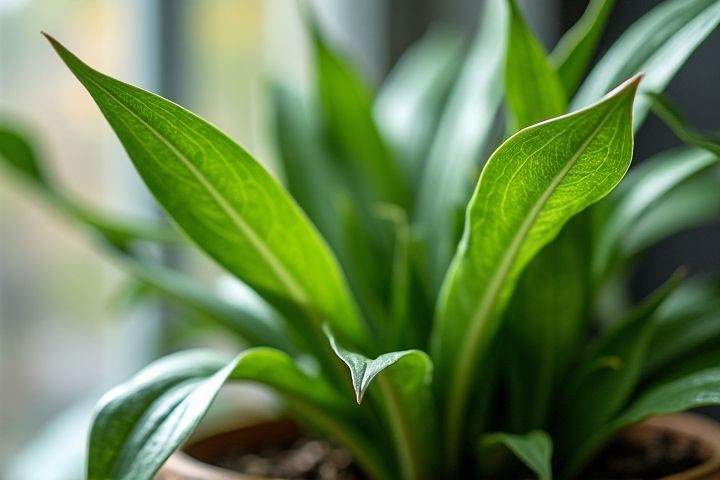
Spider plants, known for their air-purifying capabilities, effectively remove pollutants like formaldehyde and xylene from indoor environments. Snake plants, also referred to as Sansevieria, excel at filtering out toxins and release oxygen at night, making them ideal for bedrooms. Peace lilies not only enhance decor but also absorb harmful chemicals such as ammonia, benzene, and carbon monoxide, promoting a healthier living space. Bamboo palms thrive in low light and help increase humidity while eliminating various air contaminants. Including these plants in your home can significantly enhance air quality and contribute to a more enjoyable atmosphere.
What House Plants Improve Air Quality
Snake Plant
The Snake Plant, scientifically known as Sansevieria trifasciata, is renowned for its air-purifying properties, effectively filtering toxins like formaldehyde and benzene from your indoor environment. Research indicates that this hardy plant can convert up to 24% of carbon dioxide into oxygen, helping to enhance air quality, especially during the night when most plants release carbon dioxide. With minimal care requirements, it thrives in various lighting conditions, requiring only occasional watering, making it suitable for both beginner and experienced plant enthusiasts alike. By incorporating a Snake Plant into your home, you not only beautify your space but also create a healthier atmosphere for living and working.
Spider Plant
The Spider Plant (Chlorophytum comosum) is renowned for its air-purifying qualities, effectively removing harmful pollutants such as formaldehyde and xylene. This hardy houseplant thrives in a variety of conditions, requiring minimal maintenance while adapting to diverse light levels. Its arching green leaves with white stripes not only enhance your living space but also promote a healthier indoor environment. By incorporating a Spider Plant into your home or office, you can enjoy improved air quality and a touch of natural beauty.
Peace Lily
The Peace Lily, known for its elegant white blooms and glossy leaves, is an exceptional houseplant that enhances indoor air quality. It effectively filters harmful toxins such as ammonia, benzene, and formaldehyde, making it an ideal choice for your home or office. This low-light tolerant plant thrives with minimal care, requiring only occasional watering and indirect sunlight. Incorporating a Peace Lily into your space not only elevates aesthetics but also contributes to a healthier indoor environment.
Aloe Vera
Aloe Vera, a succulent that grows up to 2 feet tall, is renowned for its air-purifying properties. Studies by NASA have shown that it can remove up to 90% of formaldehyde and benzene from indoor air within 24 hours. This hardy plant thrives in well-draining soil and needs minimal watering, making it ideal for busy individuals. Placing an Aloe Vera plant in your home not only enhances air quality but also adds a touch of greenery to your space.
Boston Fern
The Boston Fern (Nephrolepis exaltata) is an exceptional house plant known for its air-purifying capabilities, effectively removing formaldehyde and other toxins from indoor environments. This lush, feathery fern can remove up to 85% of certain air pollutants within a week, significantly enhancing the overall air quality in your home. Thriving in humid conditions with indirect light, the Boston Fern requires consistent moisture, making it an ideal choice for bathrooms or kitchens. Your periodic care, including misting and ensuring proper drainage, will help maintain its vibrant green foliage while promoting a healthier living space.
Bamboo Palm
The Bamboo Palm (Chamaedorea seifrizii) is a top choice for improving indoor air quality, effectively filtering harmful pollutants such as benzene, formaldehyde, and trichloroethylene. Growing up to 10 feet tall, this versatile house plant thrives in bright, indirect light, making it suitable for various indoor environments. With its graceful fronds, the Bamboo Palm can also increase humidity levels in your home, contributing to a more comfortable atmosphere. For optimal growth, maintain a temperature range between 65degF and 75degF and keep the soil consistently moist but not soggy.
English Ivy
English Ivy (Hedera helix) is a powerful air-purifying houseplant known for its ability to filter out harmful toxins such as formaldehyde, benzene, and xylene. This hardy vine thrives in various light conditions but prefers indirect sunlight, making it suitable for indoor environments. You can cultivate English Ivy in hanging baskets or as a climber on trellises, enhancing your living space's aesthetic while promoting cleaner air. Incorporating this versatile plant into your home can significantly contribute to a healthier atmosphere, improving overall well-being.
Rubber Plant
The Rubber Plant (Ficus elastica) is known for its ability to filter toxins such as formaldehyde and other harmful chemicals from indoor air. With growth heights reaching up to 100 feet in their natural habitat, these plants thrive in indirect light and require moderate watering, making them ideal for home or office environments. Studies indicate that having Rubber Plants indoors can increase humidity levels, which in turn can help reduce respiratory issues and improve overall air quality. For optimal air purification, consider placing your Rubber Plant in a location with bright, indirect sunlight and avoid over-watering, which can lead to root rot.
Dracaena
Dracaena, a popular houseplant, is renowned for its air-purifying qualities, effectively removing toxins such as formaldehyde, benzene, and trichloroethylene. With its striking long leaves and various species, including Dracaena marginata and Dracaena fragrans, these plants thrive in indirect sunlight and require minimal upkeep, making them ideal for indoor environments. By incorporating Dracaena into your living space, you can enhance air quality, creating a healthier atmosphere that promotes well-being. In addition to improved air purification, Dracaena also adds a touch of greenery, contributing to your home's aesthetic appeal.
Lady Palm
Lady Palm (Rhapis excelsa) is an exceptional houseplant known for its air-purifying qualities. Studies indicate that it can effectively remove indoor pollutants such as formaldehyde and benzene, enhancing the overall air quality in your home. With an optimal height of 3 to 6 feet, it's suitable for both small and large spaces, adapting well to various lighting conditions. By adding this resilient plant to your interior, you can enjoy cleaner air while also enhancing your living space's aesthetic appeal.
